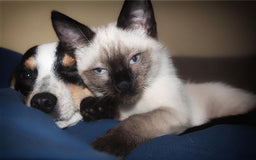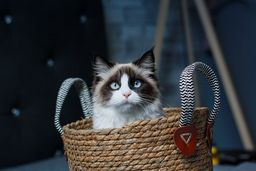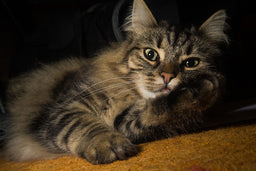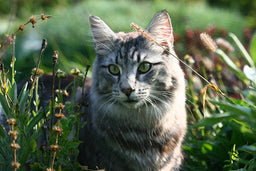When do Ragdoll cats stop growing? Do you need to knock through?
You’ve reached the magical 12 months, and you’re starting to believe your cat food costs should start going down as your Ragdoll has stopped growing and reached adulthood.
Yet, your kitten continues to eat like a gannet and seems to grow every day, possibly soon being in danger of outgrowing the space you have made available.
When do Ragdoll cats stop growing? Get all the info you need on how long you can expect your Ragdoll to carry on increasing in size, what food to choose, and how to make sure Ragdoll kittens become healthy adults.

From this…
Source: Pixabay
Ragdoll cat growth phases
From birth until 6 weeks, Ragdolls—like other larger breeds, such as Maine Coons, Bengals, Norwegian Forest cats, and Siberians—grow from around 100 grams birth weight to approximately 300 grams.
During this time, they will usually transition to solid food, at which point their growth rate will increase exponentially.
The most important milestones in your Ragdoll’s growth are at:
- 6 weeks
- 10 weeks
- 12 weeks
- 3 months
- 6 months
6-week-old Ragdoll kittens
At 6 weeks, Ragdolls have usually reached the 400-gram mark, and they will have started to explore independently of their mothers.
The first signs of the Ragdoll’s strong personality will begin to show through, and the typical physical characteristics of the breed—such as the blue eye colour—will make an appearance.
10-week-old Ragdoll kitten milestones
By the time they reach the 10-week mark, Ragdolls should be able to keep themselves clean, and their digestive system should be fully functional.
Their weight should be around 700 grams, and they should be energetic, inquisitive, and full of fun.
12-week-old Ragdoll kitten development
At 12 weeks, Ragdoll kittens are growing almost visibly, reaching around 1.2 kilos by this point.
They should be ready to leave their mothers, and most kittens not destined for breeding are neutered at around this point.
3-month-old Ragdoll kitten expectations
At the age of 3 months, you should expect a Ragdoll kitten to look like a miniature adult, weighing in at around 1.4 kilos.
The kittens should teethe from month 4 onwards, and you should be careful to make sure they are being fed adequately as growth during this phase remains rapid.
6-month-old Ragdoll kitten weight
At 6 months, Ragdoll kittens should weigh around 2.5–2.7 kilos.
Growth will now start to tail off, but you may notice occasional growth spurts, meaning that you need to ensure your kitten is not being underfed. Their growth will not be predictable, so careful weighing, observation, and making sure enough food is on offer are crucial to keeping on top of a Ragdoll teenager’s calorific needs.
If any behavioural problems are going to develop, you may notice the first signs from 6 months onwards. Ragdolls are generally highly trainable, so the more time you spend with your adolescent cat, the better you will be able to instil good behaviour.
At 12 months, your Ragdoll officially becomes an adult cat, but their growth journey is not over. Having reached an average weight of 3.6 kilos, Ragdolls still have a long way to go before they are fully grown.

….to this takes time.
Source: Pixabay
How long do Ragdoll cats grow?
Ragdolls continue to grow after 12 months, often only reaching the final weight at the age of around 4 years. Their weight should hit the following approximate milestones:
|
Age |
Expected weight male |
Expected weight female |
|
12 months |
3.6 kg |
2.7 kg |
|
24 months |
6.8 kg |
5.1 kg |
|
36 months |
8.2 kg |
6.1 kg |
|
48 months |
9.1 kg |
6.8 kg |
A female Ragdoll will usually reach around 75% of the weight of a fully-grown male.
By the age of 4 years, Ragdolls will usually reach a height of 40–66 centimetres, with the female coming in at between 38 and 58 cm.
Most of the growth after the first year takes the form of muscle mass, with Ragdolls’ bodies filling out and becoming more muscular. This is in tune with their energetic lifestyle, but you need to make sure that, once growth is done and dusted, your Ragdoll doesn’t continue to expand unhealthily.
Feeding your Ragdoll for healthy growth
The right nutrition based on your Ragdoll’s natural needs is essential to make sure growth starts and stops when it should.
Ragdolls—like all cats—are obligate carnivores, meaning their diet must be meat-based to satisfy their nutritional requirements. There is no such thing as a vegan cat.
The main reason your Ragdoll needs food is to provide energy—in the form of calories—for growth. The two main sources of energy for cats have to be:
- Animal protein
- Animal fat
Animal protein
Protein is made up of amino acids—like taurine—that are used to:
- Deliver energy
- Build muscle
- Maintain organ function
- Promote healthy skin and coat
Cats can only get the amino acids they need from meat, which they find considerably easier to digest than plant-based proteins.
The digestibility of various protein sources for cats is measured by each source’s biological value (BV). The BVs of the most common ingredients in commercial cat food are:
|
Protein type and source |
BV |
|
Animal protein: |
Between 88% and 98% |
|
Vegetable protein: |
Between 45% and 68% |
Apart from not providing the full spectrum of amino acids your Ragdoll needs, vegetable protein would mean considerably higher feeding amounts to cover their nutritional requirements—your Ragdoll may end up eating all day just to get enough usable protein.
Animal fat
As well as being an excellent secondary energy source, animal fat delivers:
- Essential fatty acids for cell structural integrity
- A great taste cats adore
Animal fat—such as that found in cat jelly or gravy—is the way to solve palatability problems with your Ragdoll.
Ragdolls are notoriously fussy eaters—some may turn their nose up at wet food, while others abhor dry kibbles, and there is no standard approach to be taken with them.
The best you can do is choose a type of food that sticks to a high-protein formula with the right amount of fat. Good quantities of animal fat (up to 20%) in the food should tickle your Ragdoll’s taste buds.

Ragdolls will let you know when they’re not 100% fit.
Source: Pixabay
Can Untamed keep your Ragdoll’s growth on track?
When it comes to managing the healthy growth of Ragdolls, Untamed is your food of choice.
With twice as much exclusively animal protein as other commercial cat foods and a healthy animal fat content, every Untamed recipe—whether you choose Chocka Chicken, Tuck-In Tuna, or Full-On Fishy—is formulated to give your Ragdoll exactly the right balance of:
- Energy for growth and activity
- Vitamins and minerals for healthy bodily functions
- Great taste to keep your kitty happy
While they started life as homemade meals, Untamed formulas have been honed by vets to make sure they:
- Contain no known allergens, so they are safe even for sensitive and allergy-prone cats
- Are made from only the best ingredients, with no additives, preservatives, or artificial flavour enhancers
- Provide the best nutrition for every Ragdoll, from kitten to senior
Untamed is also committed to ethical production and shipping methods, meaning that what’s good for your Ragdoll is also good for the planet.
Want your Ragdoll to grow up well-proportioned, lean, and fit and have a long, happy life? Try Untamed and see the difference we can make!
Getting Untamed for your Ragdoll
It’s never too late to help your Ragdoll grow into a healthy adult, and Untamed makes switching food easy!

The perfect way to help your Ragdoll achieve maturity.
Image (c) Untamed
All you have to do to get Untamed cat food delivered to your door is:
- Tell us about your Ragdoll
- Select the products
- Order your trial pack
Your tailored trial pack will arrive in no time, and your Ragdoll can start exploring Untamed’s healthy taste sensations right away. We’ll make sure you don’t run out, and—according to our countless satisfied Ragdoll parents—you should start seeing:
|
Timeline |
Untamed effects on your Ragdoll |
|
In a week |
|
|
After 2 months |
|
|
Within 4 months |
|
|
For life |
|
High-quality nutrition helps you avoid common Ragdoll health issues
Ragdolls can suffer from several health issues, most of which can be avoided with the right diet.
The most common health niggles you may see in this breed are:
Stomach sensitivity
Besides being fussy eaters, Ragdolls also suffer from periodic gastrointestinal problems.
These can take the form of:
- Diarrhoea
- Nausea or unwillingness to eat
- Vomiting, including throwing up undigested food
- Irritable bowel syndrome (IBS)
- Constipation
Such problems can be a major worry while your cat is still growing, particularly if the symptoms last for more than 24 hours. After this time, many cats begin to mobilise fat reserves to provide energy. This can flood the liver with sugar stored for processing as fatty cells around the liver’s surface, thereby impairing liver function. The resulting hepatic lipidosis can require a long convalescence and a special diet to restore liver function.
Good wet food containing meat and animal fat as its principal ingredients should nourish your Ragdoll’s digestive system, meaning that most tummy upsets can be avoided.
Shedding and hairballs
With such a luxurious coat, Ragdolls tend to shed excessively.
This is not only a problem for your vacuum cleaner but can also result in your Ragdoll producing large numbers of hairballs. This is nothing unnatural, but anything you can do to reduce the stress of hairball regurgitation will help both your Ragdoll and you (especially if you’re allergic).
A diet rich in animal protein can help keep shedding to a minimum and give your feline companion a more resilient and sturdy coat.
Urinary tract diseases
UTIs such as cystitis or bladder stones are common among Ragdolls, beginning from the age of 8 months onwards.
Food that contains meat as its main ingredient and high moisture levels is the best way to prevent your Ragdoll from suffering unnecessarily.
Animal protein helps keep the acidity of a Ragdoll’s urinary tract at the optimum level, hindering the formation of struvite and oxalate crystals.
Weight issues
By far, the most common problem Ragdolls suffer from is not knowing when to stop growing.
Once the growth has started going sideways rather than upwards, you need to take action.
Being overweight can be particularly hard on an already large cat and may result in mobility difficulties and joint issues, but longer-term effects of being a fat cat can include:
- Diabetes and pancreatitis
- Heart issues
- Hyperthyroidism
Most weight issues in Ragdolls are caused by an inappropriate diet. Cheaper cat food manufacturers tend to bulk up their products with carbohydrates, with two major effects:
- The strain of coping with the sudden rush of sugar released by the carbs causes lethargy
- Unburnt sugar in the blood is stored as fatty cells around the body
A grain-free diet with zero carbs can alleviate this problem and keep your Ragdoll lean and muscular.



